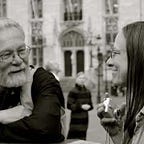More to Say About Dialogue
My most recent post, Much to be Said About Dialogue, touched on a few common problems (and how to fix them) when contemplating dialogue in your stories. One was the use of said as the go-to attribution to identify the speaker.
But said can be overused.
“I don’t want to go to the movies,” Justin said.
“You never want to see a movie,” Josie said. “How about dinner at that little seafood place on the pier?”
“Nah, the service is terrible,” he said.
“But the food’s good,” she said.
As a reader, boredom quickly sets in and casts a pall over the conversation and the story as a whole. Can you think of a worse response?
Once the characters are established within a conversation, the attributions and beats are only necessary if the back-and-forth is prolonged, in order to keep the reader “in place.”
In the example, tension exists but is minimal — -conflict does not (and cannot) be earth-shattering all the time, but should be apparent at least as an undercurrent.
Rewriting the example conversation might look like this:
“I don’t want to go to the movies,” Justin said.
Josie sighed. “You never want to see a movie. How about dinner at that little seafood place on the pier?”
“Nah, the service is terrible.”
“So what do you want to do? The pub and a plate a fries, I suppose.”
His face lit up. “That’s a great idea.”
So much for a nice quiet night, just the two of us.
One of the main purposes of using dialogue attributions is showing who is speaking — -the reader must never be confused. Adding character movements, beats, or thoughts helps make clear who is speaking; the reader will know the speaker and their emotional status, which should include tension. Differences in vocabulary, emphasis, and cadence will also help differentiate the characters.
Adding an -ly adverb to describe how the character is talking (Frank said nervously) weakens the character’s words. Here’s another type of attribution that will throw off a reader and scream amateur:
“You better not be going over to that boy’s house,” he snarled.
“Billy’s a nice boy,” she replied, “and he treats me good.”
“What do you know about it? You’re only fifteen.”
“I know enough,” she exclaimed.
“Don’t take that tone with me, young lady,” he said through gritted teeth.
Had enough? For one thing, people don’t snarl, dogs do; replied is redundant; if the girl in this encounter (supposedly the daughter) exclaims, let her do so, but don’t tell the reader.
Through gritted teeth. As a writer, you may be able to get away with that particular phrase once in a novel . . . maybe. Putting the action before the spoken words would be more effective:
He gritted his teeth. “Don’t take that tone with me, young lady.”
Add her reaction and you have a scene rife with tension. Or, even better, leave off the last beat and let the words speak for themselves — -they show the rising emotions and tension during the exchange.
“You better not be going over to that boy’s house,” he said.
“Billy’s a nice boy, and he treats me good.”
“What do you know about it? You’re only fifteen.”
“I know enough!”
“Don’t take that tone with me, young lady.”
Smoother, wouldn’t you agree? Smooth transition from one character to another is the key to believable dialogue. And please, never this:
“How you doing?” Ralph asked. (asked is unnecessary because of the obvious question.)
“Great, you?”
“Fine, thanks. What did you do last night?”
“Stayed home and played video games. What’d you do?”
As a reader, do you care?
Believable and trustworthy dialogue in fiction is vital. Having your characters speak to one another accomplishes several things in relatively few words: adds depth and substance to the characters, an important aspect in the reader’s illusion that the “people” populating your stories are real and multi-dimensional; dialogue, and the white space breaking up long narrative blocks of print, allows the reader to catch a breath; people talking speeds up the prose, the action, and the plot.
The last point is invaluable. If while reading your story over and you find it’s dragging, adding dialogue moves the story into second gear.
Word of caution: don’t use dialogue to inform the reader information you deem necessary that the characters would already be aware of.
“As you know, Dobson, a person’s molecular structure changes when in space. Your experiments prove that space travel can also alter DNA, if only marginally.”
“That’s true, David, but it has only been tested while in orbit. What you are talking about is inter-planetary travel. There’s a difference.”
“Perhaps.”
I enjoy writing dialogue: it’s challenging, and when done right, brings to life the characters, their conflicts, and adds a robust flare to the other story parts.
Practice writing dialogue. Here’s a little exercise to open a well-spring of ideas:
“I know you love me, honey. I’m just not sure if you like me.”
See how many different paths a conversation begun this way might travel. A husband and wife? Lovers? Remove “honey” and have the conversation take place between a father and son, mother and daughter, or siblings — -tension is inherent in these few words regardless of the cast of characters.
See you on the next page,
Rick
If you enjoyed this article, Sign up to follow Knights of Writ — Fiction Musings, and receive all future posts in your email. SHARE with fellow writers, and as always, comments are encouraged and highly appreciated.
Writing Quote:
“Dialogue is not just quotation. It is grimaces, pauses, adjustments of blouse buttons, doodles on a napkin, and crossings of legs.” ~Jerome Stern, Making Shapely Fiction, 1991
Writing Links: Free stories and places to send your fiction:
